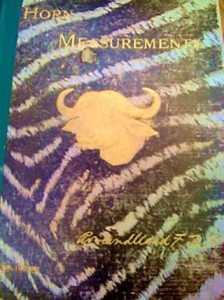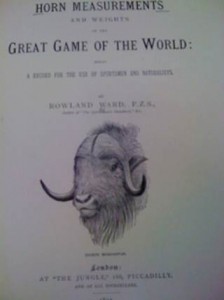 You never know what you will find in the stacks!
You never know what you will find in the stacks!
This time, we found Horn Measurements and Weights of the Great Game of the World: Being a record for the use of sportsmen and naturalists, by Rowland Ward. The book was published, of course, in London “At the Jungle” (aka 116 Piccadilly) in 1892.
This book is 120 years old and was written for “ gentlemen sportsmen and scientific men who are interested to see comparable measurements at a glance.” The true sporting gentleman, apparently, needed a quick reference for Hippo tusks. You can find the measurements of Hippopotamus tusks from Africa, Hog Deer tusks from India, Cape Buffalo tusks from Lower Zambezi River in Africa, just to name a few of the many animals covered in this 260 book devoted to measurement! Interspersed throughout the text are photos of hunting parties as well as wonderful illustrations of animals.
The author, Rowland Ward was the last member of Ward family left in the profession of taxidermy and was an appointed naturalist to the court ( and not the judicial kind–the royal court of England!). In fact there is even a Rowland Ward website which sells specialty books, record books, and hunting supplies. They also have a great summary of the history of the company and Rowland Ward himself on their web site’s history section.
fact there is even a Rowland Ward website which sells specialty books, record books, and hunting supplies. They also have a great summary of the history of the company and Rowland Ward himself on their web site’s history section.
You can take a look at the book in our library in the stacks, where you’ll find it at QL737 U4 W3, on the fourth floor. If some adventure enthusiast was there before you, you can also take a look at an electronic version through the Internet Archive.
You may wonder why on earth a person who doesn’t hunt big game (perhaps, these days, by camera…) might care about this book, beyond the fact that it’s 120 years old, but there are lots of reasons!
For historians of empire, this might be a great book. An English literature scholar might want to investigate the relationship between dominating and experiencing nature in the book’s rhetoric. It could even be useful for scientists. The data in a book like this can be used by scientists to compare current conditions and ranges for animals. In a reference question last year, we were able to use books like this one to establish a historical range for large mammals, so that a student could contextualize their research and make some conclusions about the ecosystem they were studying.
– Rebecca Kuglitsch
